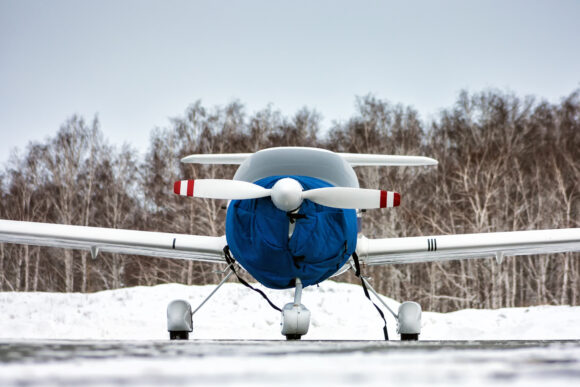This post is part of a series sponsored by IAT Insurance Group.
Most aviation accidents are due to human error. An estimated 69% of general aviation non-commercial fixed-wing aircraft accidents in 2021 were caused by pilot mistakes. The right winter preparation, though, can help you stay safe and avoid disastrous outcomes during cold-weather aircraft operations.
5 ways to maintain safe winter aircraft travel
Proactive cold weather planning can prevent costly errors and save time, resources and most importantly, lives. Here are five ways to keep yourself, your passengers, and your aircraft safe this winter:
1. Get your cold weather operations in order.
Pay special attention to the following items during the winter season:
- After landing, top off fuel tanks to prevent new moisture from forming. Always sump your fuel during pre-flight to remove any contaminants and more importantly, water. If possible, this should be conducted in a heated hangar to ensure that any ice is melted and removed from the tanks.
- If your aircraft has a carbureted engine, use carb heat during reduced power settings to prevent or melt carb icing. Always consult your pilot operating handbook first as carburetor ice can cause engine partial or complete power loss. Carb ice typically forms below 70 degrees Fahrenheit with 90% humidity, but it can even form at 100 degrees Fahrenheit and 50% humidity.
- Make sure your cabin has a working carbon monoxide detector that will alert you early to any problems that might arise since a leak of the exhaust system into the cabin heating system can cause serious problems quickly.
- Cover the pitot tube, vents, and engine inlets to keep insects and small animals out of your aircraft. It doesn’t take much for these small passengers to cause serious damage.In a $1 million loss incident, the airplane wing was totaled after mud dauber wasps took up residence in the fuel vent, preventing the equalization of pressure in the wing, during high-altitude flight. Rodents seeking warmth also can get inside your engine via uncovered engine inlets. They can chew the fuel line and leave you suddenly stranded without fuel mid-flight.
- Always have a winter survival pack on board. If you must make an emergency landing, having blankets, gloves, hats, food and water can be the difference between life and death. Review the Federal Aviation Administration’s (FAA) comprehensive winter survival kit checklist to see the 14 items you should always have in your pack.
2. Stay current in your licensure.
Think of your pilot’s license as an ongoing opportunity to refresh your knowledge, gain new insights and sharpen your skills. Attend safety seminars to learn from other people’s mistakes. Don’t negate the importance of knowing your own airplane. If you’re transitioning to a new or unfamiliar aircraft or if you’re facing any challenges with your existing aircraft, spend time with a certified flight instructor (CFI) to get the help you need to fly safely.
Simulators and rental aircraft of the same make and model are useful, but your airplane may have equipment and safety features that differ from other airplanes you’ve flown. In serious situations, such as a vacuum or electrical failure in instrument meteorological conditions (IMC), familiarization with your own airplane can be life-saving.
A pilot accumulated a considerable amount of sim time and plenty of time with his CFI, but he didn’t realize his aircraft had a feature that the flight simulator didn’t. This is an example of a fatal accident that could’ve been prevented had the pilot flown his own aircraft and not just a simulator. During an event in-flight, that one feature probably would have saved his life had he known it was there.
In addition, you might require your frequent passengers to take companion co-pilot courses where they’ll learn the life-saving basics of how to operate an aircraft in the event of an emergency.
3. Respect your personal limits.
Conduct and follow the FAA’s IM SAFE Personal Checklist before every flight to determine if illness, medication, stress, alcohol, fatigue and/or emotion could affect your ability to focus on the airplane. Beyond FAA and aircraft certification limits, it’s important to set and stick to your own personal boundaries as well. If you haven’t flown in IMC conditions or there’s a strong crosswind, be realistic about what you can handle. Respect your own limits, and you’ll avoid most of the claims that we see.
4. Take preflight and prelanding preparation seriously.
While preflight preparation is a requirement, pilots often rush or become distracted and forget to take all necessary actions. Always complete your walk-around procedure, and triple check fuel lines, fuel caps and quantities.
Study airport maps, listen to radio communications and read pertinent Notice to Air Missions (NOTAMs). You may be tempted to neglect this if you’re familiar with the airport, but there are many variables that can change. Look to the NOTAMs for airport alerts about everything from closed taxiways to an influx of birds at the airport that day.
Once you’re in the air, use GUMPS to remember your prelanding checklist: Gas, Undercarriage, Mixture, Propeller and Switches / Seatbelts. Forgetting to lower your gear for landing, for example, can total your airplane.
Most important: Do not accept an Air Traffic Control (ATC) clearance you aren’t comfortable completing and could pose a safety issue. Pilots often feel obligated to do whatever the air traffic controller says, but you are the final authority and you are ultimately responsible for your decisions and actions.
In one tragic scenario, a pilot was flying with his wife and friend when ATC told him to keep it in tight, turn base now, cleared to land. The pilot had some maneuvering errors that resulted in an accelerated stall, and the plane crashed, killing everyone on board. If you find yourself in an uncomfortable situation, prioritize safety, extend your pattern if you’re in heavy traffic situations and ask ATC for an amended clearance.
5. Engage in preventative maintenance.
Engines perform better and typically give you a smoother ride in cold weather, but don’t let that delay your maintenance schedule. Airplane maintenance is dictated by time, not distance, and an overhaul of the engine, propeller or certain components is recommended or required after a specified threshold (commonly 2,000 to 2,400 hours of flight time or 60 months) is reached. Always check with your engine, propeller or component manufacturer for recommended maintenance schedules.
In addition, regularly use your airplane since sitting engines can deteriorate rapidly. Oil that sits stagnant in your engine can cause corrosion and other issues. Regular oil changes (per your engine manufacturer’s recommendation), especially during prolonged downtime periods, can minimize deterioration.
Prevent what you can and plan for the unexpected
Accidents can still happen even with the best cold weather preparation, so take these steps to ensure you’re operating your airplane efficiently and adhering to potential coverage mandates:
- Always log your flight time, even if you aren’t building time to fly commercially. Many insurance policies require a minimum number of flight hours to qualify, and more experience can equal better rates. You’ll be required to supply your logbook for proof.
- Read your policy and review your pilot requirements. Confusion can arise from the differences that exist between insurance and pilot requirements, so if there’s anything you don’t understand, just ask!
Take the instrument proficiency check (IPC), for example. Technically, this requirement applies if the pilot has not met instrument currency requirements within six calendar months, but some insurance policies require an IPC every year regardless of FAA requirements. In one instance, a claim was denied after a fatal accident because the pilot had not completed his IPC within 12 months, and his widow received no coverage for the airplane or her husband’s death.
Every policy also outlines specific pilot requirements and qualifications. If, for example, you lend your airplane to a friend who doesn’t meet those requirements, your plane is now uninsured.
The winter weather is full of beauty and wonder — especially when flying — so make the most out of your season and do everything you can to stay safe while in the air.
ASK A LOSS CONTROL REPRESENTATIVE
Have a question on how to mitigate risk? Email losscontroldirect@iatinsurance.com for a chance to see your question answered in a future blog.
By Jessica Kernan, Bryan Osejo and Lauren August
Topics
Aviation











